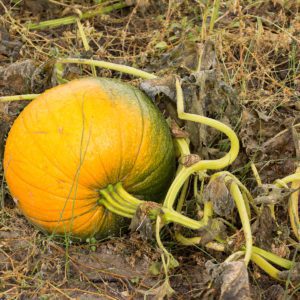If you have a family tradition of gathering around the table to carve plump, orange pumpkins on Halloween, it’s not too late to plant your own. Growing pumpkins isn’t too difficult as long as you’ve got the right circumstances and conditions and provide them with proper care in the months leading up to late October. If you want to grow your own pumpkins in time for Halloween, we’ll guide you through the simple and rewarding process!
How to Grow Pumpkins for Halloween
Variety
Choosing the right pumpkin variety is a good place to start. You’ll want to balance the look of pumpkin you want with the climate you live in. No two pumpkin varieties are the same, so it might be a good idea to browse our extensive collection of heirloom pumpkin seeds to choose the varieties that will work best in your garden. Of course, if you’re looking for the classic Halloween pumpkins, varieties such as the 6lb Spookie or the massive Big Max are great options to plant in your garden.
There is a wide variety of pumpkins to choose from for look, size or taste, but be sure the varieties you decide on are good for your growing region.

Planting
Pumpkins do best when direct sown into the soil. Choose a sunny spot with lots of room for the vines of the plant to spread. You’ll want to try to choose a spot with minimal grass or weeds, but if this space is at a premium, grab a bail of straw or hay and mulch the area around where you plan to plant your seeds.
To grow so large, pumpkins have a big appetite, so create a mound of rich soil amended with aged manure, compost, and any other soil amendments you might have lying around. Build up your soil mounds as large as you can get them—3’x3’ is preferred—this will be beneficial in the early stages of growth as well as the later stages as it reduces excess moisture which can lead to issues.
Direct sow 5 seeds per mound and keep watered until the plants sprout which should take about a week depending on the variety. Once the plants get a few inches tall, cull all but the biggest and strongest 3 of the bunch per mound.
Vine Care
You’ll be surprised how quickly your pumpkin vines will begin to spread, shooting off into the direction of their choosing. As your pumpkins grow, continue to water them throughout the week taking care to avoid watering the vines themselves. Getting water on the vines can lead to rot and disease so its best to avoid it altogether, but don’t let that stop you from ensuring your mounds are being properly hydrated to ensure an excellent harvest.

Eventually, as your vines grow, you’ll start to see big, beautiful yellow-orange flowers forming. Gourds have both male and female flowers. The easiest way to tell the difference is that a female flower will have a tiny, baby pumpkin at its base. Both flowers are needed for pollination, otherwise the baby pumpkins will die with the flower. It’s a good time to mention the importance of bees when pollinating any fruiting plant, so remember to plant flowering plants in your yard to ensure attract bees and encourage proper pollination. If for some reason you’re having issues with bees, you can hand pollinate your flowers by collecting pollen from a male flower with a soft paintbrush and then gently brushing it onto your female flowers.
You’ll know your pumpkins have been successfully pollinated when the flower dies off leaving a tiny green fruit behind. Continue to care for, water and fertilize your pumpkins through the growing season, ensuring you keep pests and weeds at bay!
Companion Considerations
The Native Americans had an impressive knowledge of growing to maximize space and harvest, and made use of companion planting to accomplish it. They knew that certain plants when grown together made them all happier. In the case of pumpkins, they had the three sisters: pumpkin (or squash), beans and corn.
The pumpkin protects the ground, keeping weeds down, while the corn provides a trellis for the beans to climb. The beans then supplied additional nitrogen to the soil, helping both the corn and the pumpkin grow big and strong.
If you’re interested in growing more than just pumpkins, consider using this “three sisters” that the Native Americans created to ensure your harvest is bountiful. It’s also a great way to introduce the little ones to the idea of plants working together as a team!
If the idea of walking around your garden with your children and family, picking big, beautiful pumpkins you grew yourself and creating lasting memories in the process, consider planting your own pumpkins! They’re great for Halloween traditions—and Thanksgiving, too.